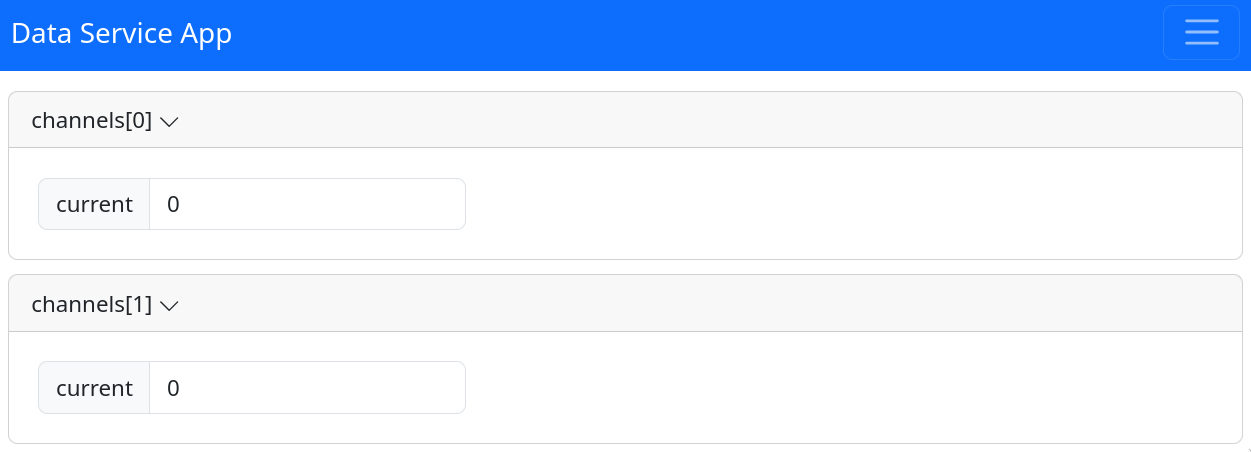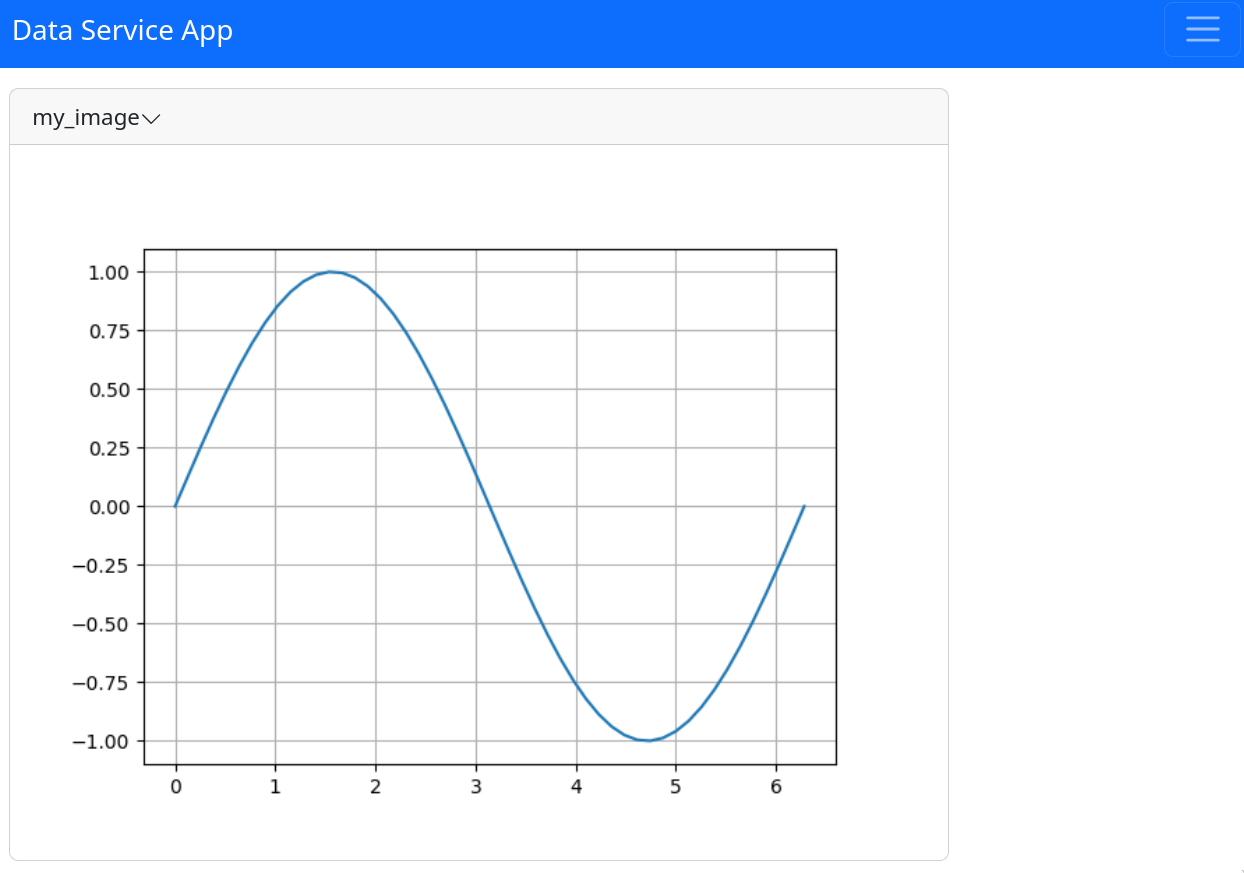16 KiB
Components Guide
In pydase, components are fundamental building blocks that bridge the Python backend logic with frontend visual representation and interactions. This system can be understood based on the following categories:
Built-in Type and Enum Components
pydase automatically maps standard Python data types to their corresponding frontend components:
str: Translated into aStringComponenton the frontend.intandfloat: Manifested as theNumberComponent.bool: Rendered as aButtonComponent.list: Each item displayed individually, named after the list attribute and its index.dict: Each key-value pair displayed individually, named after the dictionary attribute and its key. Note that the dictionary keys must be strings.enum.Enum: Presented as anEnumComponent, facilitating dropdown selection.
Method Components
Within the DataService class of pydase, only methods devoid of arguments can be represented in the frontend, classified into two distinct categories
- Tasks: Argument-free asynchronous functions, identified within
pydaseas tasks, are inherently designed for frontend interaction. These tasks are automatically rendered with a start/stop button, allowing users to initiate or halt the task execution directly from the web interface. - Synchronous Methods with
@frontendDecorator: Synchronous methods without arguments can also be presented in the frontend. For this, they have to be decorated with the@frontenddecorator.
import pydase
import pydase.components
import pydase.units as u
from pydase.utils.decorators import frontend
class MyService(pydase.DataService):
@frontend
def exposed_method(self) -> None:
...
async def my_task(self) -> None:
while True:
# ...
You can still define synchronous tasks with arguments and call them using a python client. However, decorating them with the @frontend decorator will raise a FunctionDefinitionError. Defining a task with arguments will raise a TaskDefinitionError.
I decided against supporting function arguments for functions rendered in the frontend due to the following reasons:
- Feature Request Pitfall: supporting function arguments create a bottomless pit of feature requests. As users encounter the limitations of supported types, demands for extending support to more complex types would grow.
- Complexity in Supported Argument Types: while simple types like
int,float,boolandstrcould be easily supported, more complicated types are not (representation, (de-)serialization).
DataService Instances (Nested Classes)
Nested DataService instances offer an organized hierarchy for components, enabling richer applications. Each nested class might have its own attributes and methods, each mapped to a frontend component.
Here is an example:
from pydase import DataService, Server
class Channel(DataService):
def __init__(self, channel_id: int) -> None:
super().__init__()
self._channel_id = channel_id
self._current = 0.0
@property
def current(self) -> float:
# run code to get current
result = self._current
return result
@current.setter
def current(self, value: float) -> None:
# run code to set current
self._current = value
class Device(DataService):
def __init__(self) -> None:
super().__init__()
self.channels = [Channel(i) for i in range(2)]
if __name__ == "__main__":
service = Device()
Server(service).run()
Note that defining classes within DataService classes is not supported (see this issue).
Custom Components (pydase.components)
The custom components in pydase have two main parts:
- A Python Component Class in the backend, implementing the logic needed to set, update, and manage the component's state and data.
- A Frontend React Component that renders and manages user interaction in the browser.
Below are the components available in the pydase.components module, accompanied by their Python usage:
DeviceConnection
The DeviceConnection component acts as a base class within the pydase framework for managing device connections. It provides a structured approach to handle connections by offering a customizable connect method and a connected property. This setup facilitates the implementation of automatic reconnection logic, which periodically attempts reconnection whenever the connection is lost.
In the frontend, this class abstracts away the direct interaction with the connect method and the connected property. Instead, it showcases user-defined attributes, methods, and properties. When the connected status is False, the frontend displays an overlay that prompts manual reconnection through the connect() method. Successful reconnection removes the overlay.
import pydase.components
import pydase.units as u
class Device(pydase.components.DeviceConnection):
def __init__(self) -> None:
super().__init__()
self._voltage = 10 * u.units.V
def connect(self) -> None:
if not self._connected:
self._connected = True
@property
def voltage(self) -> float:
return self._voltage
class MyService(pydase.DataService):
def __init__(self) -> None:
super().__init__()
self.device = Device()
if __name__ == "__main__":
service_instance = MyService()
pydase.Server(service_instance).run()
Customizing Connection Logic
Users are encouraged to primarily override the connect method to tailor the connection process to their specific device. This method should adjust the self._connected attribute based on the outcome of the connection attempt:
import pydase.components
class MyDeviceConnection(pydase.components.DeviceConnection):
def __init__(self) -> None:
super().__init__()
# Add any necessary initialization code here
def connect(self) -> None:
# Implement device-specific connection logic here
# Update self._connected to `True` if the connection is successful,
# or `False` if unsuccessful
...
Moreover, if the connection status requires additional logic, users can override the connected property:
import pydase.components
class MyDeviceConnection(pydase.components.DeviceConnection):
def __init__(self) -> None:
super().__init__()
# Add any necessary initialization code here
def connect(self) -> None:
# Implement device-specific connection logic here
# Ensure self._connected reflects the connection status accurately
...
@property
def connected(self) -> bool:
# Implement custom logic to accurately report connection status
return self._connected
Reconnection Interval
The DeviceConnection component automatically executes a task that checks for device availability at a default interval of 10 seconds. This interval is adjustable by modifying the _reconnection_wait_time attribute on the class instance.
Image
This component provides a versatile interface for displaying images within the application. Users can update and manage images from various sources, including local paths, URLs, and even matplotlib figures.
The component offers methods to load images seamlessly, ensuring that visual content is easily integrated and displayed within the data service.
import matplotlib.pyplot as plt
import numpy as np
import pydase
from pydase.components.image import Image
class MyDataService(pydase.DataService):
my_image = Image()
if __name__ == "__main__":
service = MyDataService()
# loading from local path
service.my_image.load_from_path("/your/image/path/")
# loading from a URL
service.my_image.load_from_url("https://cataas.com/cat")
# loading a matplotlib figure
fig = plt.figure()
x = np.linspace(0, 2 * np.pi)
plt.plot(x, np.sin(x))
plt.grid()
service.my_image.load_from_matplotlib_figure(fig)
pydase.Server(service).run()
NumberSlider
The NumberSlider component in the pydase package provides an interactive slider interface for adjusting numerical values on the frontend. It is designed to support both numbers and quantities and ensures that values adjusted on the frontend are synchronized with the backend.
To utilize the NumberSlider, users should implement a class that derives from NumberSlider. This class can then define the initial values, minimum and maximum limits, step sizes, and additional logic as needed.
Here's an example of how to implement and use a custom slider:
import pydase
import pydase.components
class MySlider(pydase.components.NumberSlider):
def __init__(
self,
value: float = 0.0,
min_: float = 0.0,
max_: float = 100.0,
step_size: float = 1.0,
) -> None:
super().__init__(value, min_, max_, step_size)
@property
def min(self) -> float:
return self._min
@min.setter
def min(self, value: float) -> None:
self._min = value
@property
def max(self) -> float:
return self._max
@max.setter
def max(self, value: float) -> None:
self._max = value
@property
def step_size(self) -> float:
return self._step_size
@step_size.setter
def step_size(self, value: float) -> None:
self._step_size = value
@property
def value(self) -> float:
"""Slider value."""
return self._value
@value.setter
def value(self, value: float) -> None:
if value < self._min or value > self._max:
raise ValueError("Value is either below allowed min or above max value.")
self._value = value
class MyService(pydase.DataService):
def __init__(self) -> None:
super().__init__()
self.voltage = MySlider()
if __name__ == "__main__":
service_instance = MyService()
service_instance.voltage.value = 5
print(service_instance.voltage.value) # Output: 5
pydase.Server(service_instance).run()
In this example, MySlider overrides the min, max, step_size, and value properties. Users can make any of these properties read-only by omitting the corresponding setter method.
-
Accessing parent class resources in
NumberSliderIn scenarios where you need the slider component to interact with or access resources from its parent class, you can achieve this by passing a callback function to it. This method avoids directly passing the entire parent class instance (
self) and offers a more encapsulated approach. The callback function can be designed to utilize specific attributes or methods of the parent class, allowing the slider to perform actions or retrieve data in response to slider events.Here's an illustrative example:
from collections.abc import Callable import pydase import pydase.components class MySlider(pydase.components.NumberSlider): def __init__( self, value: float, on_change: Callable[[float], None], ) -> None: super().__init__(value=value) self._on_change = on_change # ... other properties ... @property def value(self) -> float: return self._value @value.setter def value(self, new_value: float) -> None: if new_value < self._min or new_value > self._max: raise ValueError("Value is either below allowed min or above max value.") self._value = new_value self._on_change(new_value) class MyService(pydase.DataService): def __init__(self) -> None: self.voltage = MySlider( 5, on_change=self.handle_voltage_change, ) def handle_voltage_change(self, new_voltage: float) -> None: print(f"Voltage changed to: {new_voltage}") # Additional logic here if __name__ == "__main__": service_instance = MyService() my_service.voltage.value = 7 # Output: "Voltage changed to: 7" pydase.Server(service_instance).run() -
Incorporating units in
NumberSliderThe
NumberSlideris capable of displaying units alongside values, enhancing its usability in contexts where unit representation is crucial. When utilizingpydase.units, you can specify units for the slider's value, allowing the component to reflect these units in the frontend.Here's how to implement a
NumberSliderwith unit display:import pydase import pydase.components import pydase.units as u class MySlider(pydase.components.NumberSlider): def __init__( self, value: u.Quantity = 0.0 * u.units.V, ) -> None: super().__init__(value) @property def value(self) -> u.Quantity: return self._value @value.setter def value(self, value: u.Quantity) -> None: if value.m < self._min or value.m > self._max: raise ValueError("Value is either below allowed min or above max value.") self._value = value class MyService(pydase.DataService): def __init__(self) -> None: super().__init__() self.voltage = MySlider() if __name__ == "__main__": service_instance = MyService() service_instance.voltage.value = 5 * u.units.V print(service_instance.voltage.value) # Output: 5 V pydase.Server(service_instance).run()
ColouredEnum
This component provides a way to visually represent different states or categories in a data service using colour-coded options. It behaves similarly to a standard Enum, but the values encode colours in a format understood by CSS. The colours can be defined using various methods like Hexadecimal, RGB, HSL, and more.
If the property associated with the ColouredEnum has a setter function, the keys of the enum will be rendered as a dropdown menu, allowing users to interact and select different options. Without a setter function, the selected key will simply be displayed as a coloured box with text inside, serving as a visual indicator.
import pydase
import pydase.components as pyc
class MyStatus(pyc.ColouredEnum):
PENDING = "#FFA500" # Hexadecimal colour (Orange)
RUNNING = "#0000FF80" # Hexadecimal colour with transparency (Blue)
PAUSED = "rgb(169, 169, 169)" # RGB colour (Dark Gray)
RETRYING = "rgba(255, 255, 0, 0.3)" # RGB colour with transparency (Yellow)
COMPLETED = "hsl(120, 100%, 50%)" # HSL colour (Green)
FAILED = "hsla(0, 100%, 50%, 0.7)" # HSL colour with transparency (Red)
CANCELLED = "SlateGray" # Cross-browser colour name (Slate Gray)
class StatusTest(pydase.DataService):
_status = MyStatus.RUNNING
@property
def status(self) -> MyStatus:
return self._status
@status.setter
def status(self, value: MyStatus) -> None:
# do something ...
self._status = value
# Modifying or accessing the status value:
my_service = StatusExample()
my_service.status = MyStatus.FAILED
Note that each enumeration name and value must be unique. This means that you should use different colour formats when you want to use a colour multiple times.
Extending with New Components
Users can also extend the library by creating custom components. This involves defining the behavior on the Python backend and the visual representation on the frontend. For those looking to introduce new components, the guide on adding components provides detailed steps on achieving this.





